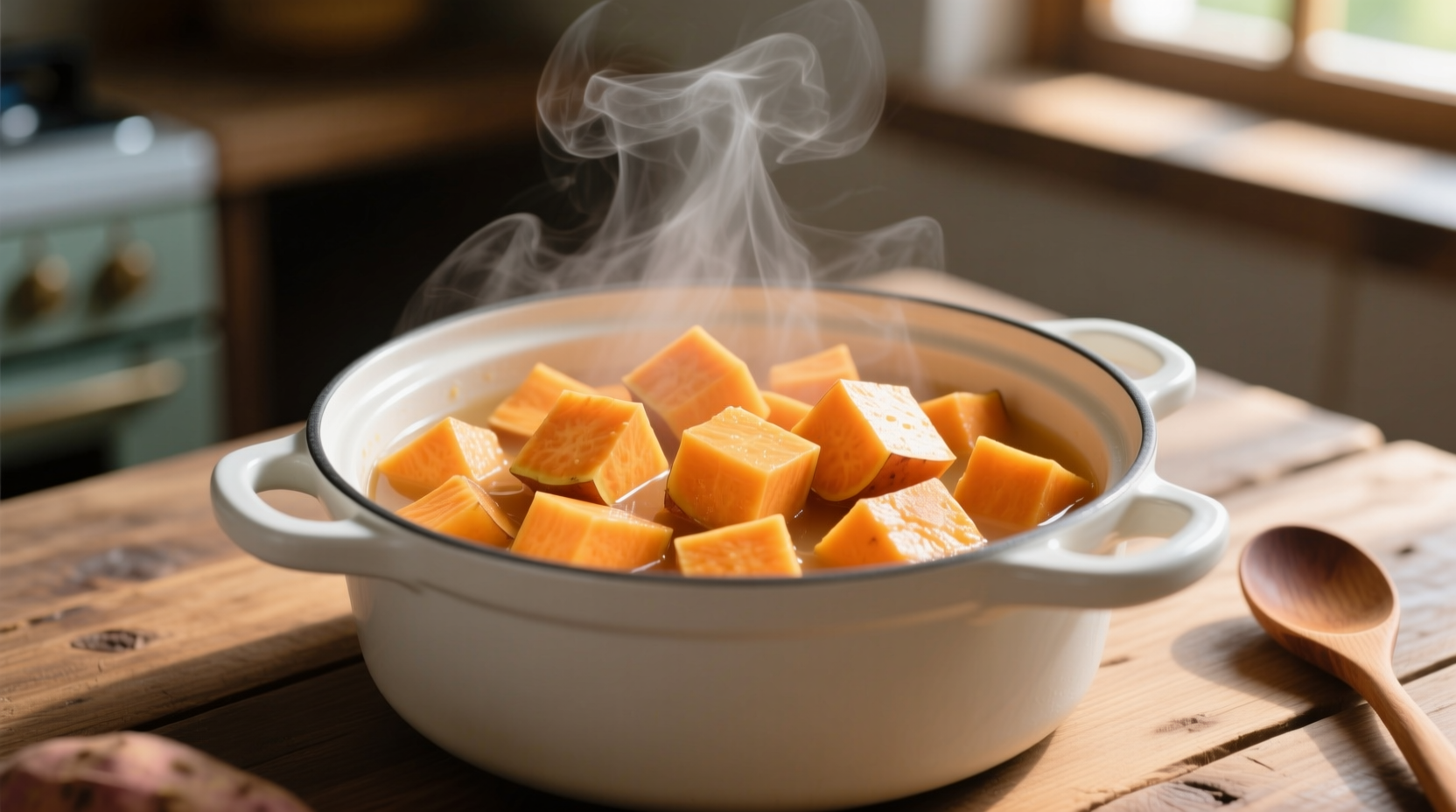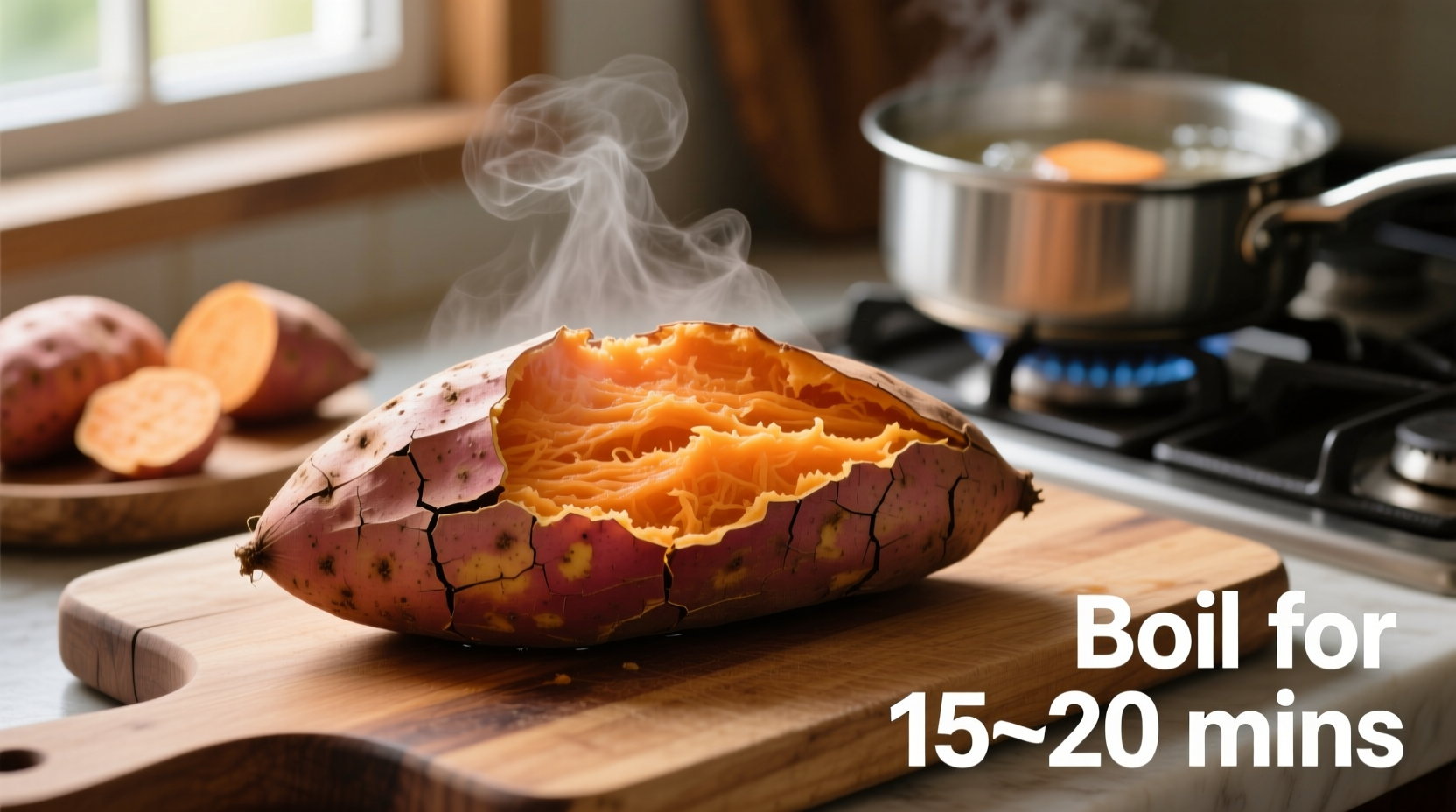Boiling sweet potatoes typically takes 20-30 minutes for cubed pieces (1-inch cubes) and 35-50 minutes for whole sweet potatoes, depending on size and variety. This precise timing ensures perfectly tender sweet potatoes without becoming waterlogged or falling apart.
Getting sweet potatoes perfectly cooked through boiling requires understanding the variables that impact cooking time. Whether you're preparing them for mashing, salads, or as a simple side dish, knowing exactly how long to boil sweet potatoes makes all the difference between a dish that's undercooked and crunchy or overcooked and mushy.
Why Boiling Time Varies for Sweet Potatoes
The exact time needed to boil sweet potatoes depends on several key factors that home cooks should consider before starting the process. Understanding these variables helps you adjust cooking times for perfect results every time.
Sweet Potato Size Matters Most
The size of your sweet potato pieces dramatically affects boiling duration. Smaller pieces cook faster but can become waterlogged if left too long. Here's a detailed breakdown of cooking times based on preparation method:
| Preparation Method | Sweet Potato Size | Boiling Time | Texture Result |
|---|---|---|---|
| Whole sweet potato | Medium (5-7 oz) | 35-45 minutes | Firm but tender throughout |
| Whole sweet potato | Large (8+ oz) | 45-55 minutes | Even cooking without mushiness |
| Cubed | 1-inch cubes | 20-25 minutes | Ideal for salads or quick mashing |
| Sliced | ½-inch slices | 25-30 minutes | Good for layering in casseroles |
This cooking time comparison comes from research conducted by the Oregon State University Extension Service, which tested various sweet potato preparations to determine optimal cooking durations while preserving nutritional value.
Step-by-Step Boiling Process for Perfect Results
Follow this professional chef-tested method to boil sweet potatoes with consistent results:
Preparation Essentials
Before you start boiling, proper preparation sets the stage for even cooking:
- Wash thoroughly - Use a vegetable brush to remove dirt from the skin
- Decide on peeling - Leaving skin on preserves nutrients but requires thorough scrubbing
- Cut uniformly - If cubing, make sure all pieces are the same size for even cooking
- Start in cold water - Always place sweet potatoes in cold water before heating
The Boiling Technique That Makes a Difference
Most home cooks make the mistake of dropping sweet potatoes into already boiling water, which leads to uneven cooking. Here's the professional approach:
- Place prepared sweet potatoes in a large pot
- Add enough cold water to cover by 1 inch
- Add 1 teaspoon of salt per quart of water (enhances flavor without making them soggy)
- Bring to a gentle boil over medium-high heat
- Once boiling, reduce to a simmer (small bubbles breaking the surface)
- Set timer based on your preparation method (refer to the table above)
How to Test for Perfect Doneness
Timing is a guideline, but the real test is texture. Here's how to check if your sweet potatoes are perfectly cooked:
- Insert a fork or knife tip into the thickest part
- It should slide in with slight resistance (not too easy, not too hard)
- For cubed pieces, they should hold their shape but mash easily
- For whole sweet potatoes, they should yield slightly when squeezed with tongs
Overcooked sweet potatoes become waterlogged and fall apart, while undercooked ones remain hard in the center. The ideal texture is tender throughout with the structure still intact.
Common Mistakes That Affect Boiling Time
Avoid these frequent errors that throw off your sweet potato boiling timing:
Starting with Hot Water
Putting sweet potatoes directly into boiling water creates a temperature shock that cooks the outside too quickly while the inside remains hard. Always start in cold water for even cooking from edge to center.
Overcrowding the Pot
When the pot is too full, water temperature drops significantly when you add sweet potatoes, extending cooking time. Use a large enough pot so pieces have space to move freely in the water.
Boiling Too Vigorously
A rolling boil breaks down sweet potatoes too quickly on the outside. Maintain a gentle simmer after the initial boil for even cooking without disintegration.
When Boiling Isn't the Best Method
While boiling works well for many applications, it's not always the ideal cooking method for sweet potatoes. Understanding these context boundaries helps you choose the right technique:
- For maximum sweetness - Roasting caramelizes natural sugars better than boiling
- For firmer texture - Steaming preserves more structure than boiling
- For nutrient retention - Microwaving preserves more water-soluble vitamins
- For quick preparation - Pressure cooking reduces time by 40-50% compared to boiling
According to research from the USDA Agricultural Research Service, boiling sweet potatoes results in greater loss of certain water-soluble nutrients compared to steaming or microwaving, though it preserves beta-carotene better than frying.
Practical Applications After Boiling
Once your sweet potatoes reach perfect tenderness, here's what to do next depending on your intended use:
For Mashing
Drain thoroughly and return to the warm pot for 1-2 minutes to evaporate excess moisture. This prevents watery mashed sweet potatoes. Add butter or cream while the potatoes are still hot for best absorption.
For Salads
After draining, spread cubed sweet potatoes in a single layer on a baking sheet to cool quickly. This prevents them from continuing to cook and becoming mushy. Toss with dressing once completely cooled.
For Freezing
Cool boiled sweet potatoes completely before freezing. For best results, spread pieces in a single layer on a baking sheet, freeze until solid, then transfer to airtight containers. Properly frozen, they'll maintain quality for 10-12 months.

Advanced Tips from Professional Kitchens
Professional chefs use these techniques to optimize sweet potato boiling:
- Add a pinch of baking soda to the water (⅛ teaspoon per quart) to help maintain vibrant color
- For extra flavor, substitute water with vegetable broth
- Save the cooking liquid for soups or sauces—it contains dissolved nutrients
- Shock small pieces in ice water after cooking if using in cold dishes to stop the cooking process
Remember that different sweet potato varieties require slight timing adjustments. Orange-fleshed varieties (like Beauregard) typically cook faster than purple-fleshed types (like Stokes). Always check for doneness starting at the minimum recommended time.
Troubleshooting Common Boiling Issues
Encountering problems with your boiled sweet potatoes? Here's how to fix them:
Sweet Potatoes Still Hard After Recommended Time
If your sweet potatoes remain hard after the expected cooking time:
- Check if pieces were cut unevenly—larger pieces need more time
- Verify your stove's heat output—some burners run cooler
- Consider your water's starting temperature—cold tap water varies by region
- Add 5-10 minutes of cooking time, checking every 3 minutes
Sweet Potatoes Falling Apart
If your sweet potatoes are disintegrating:
- You've likely overcooked them—reduce time by 5-10 minutes next time
- The water may have been boiling too vigorously
- Some varieties (like Japanese sweet potatoes) are more delicate
- Try steaming instead for more delicate varieties
Conclusion: Mastering Sweet Potato Boiling
Perfectly boiled sweet potatoes require attention to size, variety, and cooking technique. By understanding that boiling time ranges from 20-30 minutes for cubed pieces to 35-50 minutes for whole sweet potatoes, and adjusting based on your specific conditions, you'll achieve consistent results. Remember to start in cold water, maintain a gentle simmer, and test for doneness rather than relying solely on timing. With these professional techniques, you'll transform this humble root vegetable into a perfectly cooked component for any dish.











 浙公网安备
33010002000092号
浙公网安备
33010002000092号 浙B2-20120091-4
浙B2-20120091-4